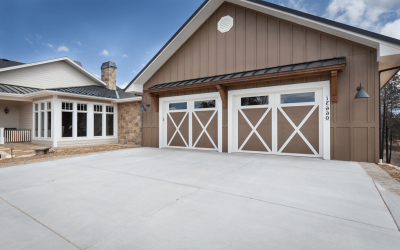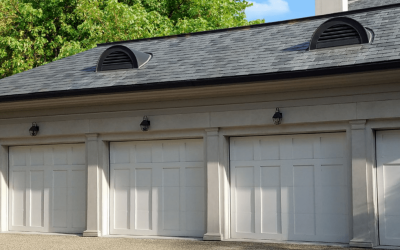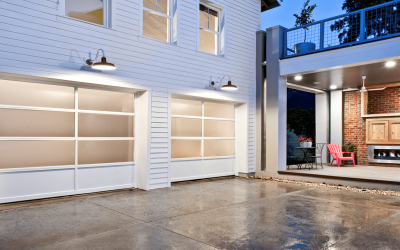Instructions for Single Spring Replacement (Continued)
- Insert the shaft into the bearing plate at the end.
- Moving toward the center of the garage door, slide the spring and cones in that direction.
- Earlier, you made marks on the shaft and the cable drum. Now you align those marks.
- Use your finger to tighten the set screws placing them into their regular indentations. To find the slots, rotate the drum.
- At this point, you should try to turn the drum while on the shaft. It should not turn if the set screws have been finger tightened properly into the original grooves. In the event you did not properly mark the drums and the shaft’s original indentations cannot be found, you should finger tighten the set screws until the shaft is met.
- Now you should tighten the set screws even more, usually an additional 1/4 to 1/2 turns. If the original set screw indentations cannot be found, add on an extra 1/4 turn. Garage doors that are made of wood and that are heavier could require an additional turn. Use extreme caution! Under-tightening of these drums can cause the drums to slip out of place resulting in the door falling. Over-tightening of the set screws can cause damage to the drum or the shaft, which will cause more problems. This step must be completed properly to ensure the project is done safely and correctly.
- The shaft should be slid toward the bearing plate’s end until you see that the cable drum is flush against the bearings’ race.
- The cable end should be bent to a 90-degree angle.
- Take the cable and insert it into the drum’s slotted part. After doing that, wrap the cable around the drum.
- Tighten the cable on the drum by twisting the shaft.
- Vise grip the shaft while twisting, ensuring the cable is tight on the drum. The vise grip’s top should be placed tightly against the garage header. Doing this will kee the cable in place on the first drum as the cable is installed on the other drum and put it in place. These steps also make sure that the shaft doesn’t turn and the cables don’t peel off as the spring winding occurs.
- When wound correctly, the cable will be tight as it comes off the cable drum.
- At the other side of the garage door, bend the other cable’s end to a 90-degree angle.
- When you get to this point, the cable should be inserted into the drum slot, then the drum should be rotated until the cable is tight.
- Pushing the shaft to the left, slide the drum against the bearing. At this point, the marks should line up. If the marks don’t line up, you need to determine the problem and promptly correct it. A common problem people face is that a cable becomes stuck on a track bracket bolt, a lock striker, or a reinforcing strut end. The garage floor can also shift, or there could have been loosening or shifting of the vertical angle, which helps to support the bearing plate. Many garage doors have also been installed leaving a gap between the bearing plate and the drum. In a garage door, the cable drums should always be flush against the race of the bearings.
- The drum’s set screws should be tightened with your fingers to the point that the drum will not turn at all.
- Now the set screws should be tightened an additional 1/4 to 1/2 turn on the other side.
- If your center bracket is slotted, you should remove the vice grip then lube the shaft at the point where it turns inside the bushing.
- The bearing should be oiled as needed. In the event there are ridges in the shaft from the bearing, they should be filed. Ensure that the shaft is free so it can slide into the bearing sideways. This is the bearing that prevents the shaft from hitting and rubbing against the stationary cones. In the event your spring anchor bracket has no bearing inside, use grease on the part of the shaft that will rub inside the cones.
- At this point, the stationary cone should be slid over to the spring anchor bracket. After this step, install the bolts. The nuts should be finger tightened until the spring anchor bracket and the stationary cones sit flush. If you force the cones by tightening the bolts, you could break the cone in the event they catch on a bearing. If a spring is wound with a cracked cone, the bar could fly and the spring could end up spinning loose. In the event they are needed, washers can be installed between the plugs to keep them from breaking. In the event your spring has cones already installed, the entire spring should be taken as a unit to the spring anchor bracket.
- The bolts should be secured. If the cones are already installed on the spring, move on to step 65.
- The spring should be gripped tightly as it is twisted onto the stationary cone. With two turns by hand, it is usually adequately wound.
- Take a pipe wrench to grip three coils, the fourth, fifth and sixth, pulling them down from the spring’s end.
- If a bolt is in the spring’s way, take that bolt off and insert only the bolt end into that stationary cone from the opposite end. Using this approach, you will keep the stationary cone attached to the spring anchor bracket.
- Keep doing this until the spring is completely wound on the cone. If you had to take a bolt off so you could install the stationary cone, that bolt should now be returned to the proper place.
- Move the winding cone. Using your hand, the cone should be screwed two turns into the torsion spring.
- Place a winding bar into a hole along the winding cone.
- The cone should be wound onto the spring. This process usually takes two more turns. At this point, pull down on the winding bar. The second winding bar should be inserted into the plug. Take out the first winding bar, then the second winding bar should be pulled down. Continue with this process until the cone cannot tighten any more.
- A winding bar needs to be put in a hole located on the winding cone’s top.
- The three coils, the fourth, fifth and sixth, should be inserted into the pipe wrench’s jaw.
- Hold the pipe wrench tightly in one hand, then grip the spring between the pipe wrench and your thumb while pulling the winding bar down.
- Bring the winding bar back above the spring after you release your grip.
- The last two steps should be repeated until the spring is fully wound onto the cone. At this point, you are almost ready to wind the spring.
- Mark the shaft right past the winding plug before you wind the spring. This would be the last step to make sure you correctly installed the proper spring on the proper side of the anchor bracket. Torsion springs always get longer after having been wound in the correct direction. In the event the spring doesn’t grow as you wind it, you can assume you are winding in the wrong direction most likely because it is not installed correctly. Some people say that they have the spring come loose from the cone after six turns or so. In the event you experience this, you have the wrong wind spring and need to attach it on the door’s other side.
- Winding bars should be taped to make certain you are inserting the bars into the cones completely as you wind springs, and to help make sure your bar doesn’t slip from the cone as the spring is stretched at the end. Springs are stretched after they have been wound because the shaft is designed to float horizontally between the end bearing plates, which are flexible, during the door’s operation. While this can be as small as aa quarter inch, the binding of the coils can keep the garage door from closing properly and completely. This is more likely when the bearings and springs are dry.
- You will now wind the springs. Chalk or paint is frequently used to mark the springs. Be sure to wind up on the torsion spring. Begin by turning the spring a quarter of a turn, continuing til it meets resistance. This equals your first quarter turn. Count one. Next you will insert the bar and raise it about 90 degrees. You then put the second bar in, which is two. The spring’s length should increase one coil’s thickness for each turn.
- The second bar should be raised about 90 degrees, so you can insert the first bar. This step is three. You should continue winding. If the spring’s length shortens, the spring should be unwound and sides should be switched because the spring is obviously on the wrong side. If things progress normally, continue winding until you reach the count of 30. For most seven foot garage doors, this is seven and a half turns. The more modern steel doors need about seven and a fourth turns. Count to 34 if it is an eight foot tall door. You should hear a click each time that the bar is inserted into the winding cone, so you know that the bar is inserted completely in the slot. The plug could explode if the bar is not inserted all the way.
- In the event the spring comes away from the plug after six or so turns, the spring is probably being wound backward. This is usually because you have the wrong wind spring. Remove the spring and place it on the spring anchor bracket’s other side. If things progress properly, secure the winding plug and stretch the springs. This can be challenging, as well as dangerous. During this process, the bar used for winding can slip from the plug as the set screws are tightened. An extra safety step is marking the bar with tape by the plug, which can help prevent slippage.
- The shaft should be marked a fourth of an inch past the winding plug with a file or permanent marker. The springs are stretched because the shaft horizontally floats between the garage door’s flexible end bearing plates as it operates. This can be as little as a quarter inch of the binding of the coils that prevents the door’s complete closure. This is more likely when the bearings and springs are dry and require proper lubrication.
- Three things will need to be done at the same time. Using your left hand, the bar should be lifted off the top of the garage door then pulled toward the garage door’s center. As you lift it up and back, the top of the bar should be tapped underneath the winding plug against the other bar. The bar being pulled back toward the door’s center while tapping keeps the spring binding on the shaft and prevents slippage.
- Tapping should continue until the plug moves from the shaft mark. The bar should be held off the door and pulled back in the direction of the door’s center. Repeat the step, if the plug slips away from the mark. Be sure to watch the tape and take precautions to prevent the bar from slipping from the cone. In the event there is slippage, rest the bar near the garage door’s top, a bar should be inserted into the next hole. The plug should be turned up enough to enable you to put the marked bar back into the right spot.
- Once the plug has met the mark, the bar should be pulled with your left hand from the garage door leaning back in the direction of the middle of the door. Both of the set screws should be tightened 1/2 to 3/4 turns each after you ensure each screw meets the shaft. At this point, you should feel the screw meet the resistance.
- Set screws should be carefully tested by you pulling down on the bar. Ensure that the winding plug is tight enough to ensure that when you pull down on the bar the garage door will start to lift off the floor. If the bar experiences slipping as you pull it downwards, add a quarter turn to each set screw. Before you attempt to remove the bars from the plugs after you have secured the winding plug, you will have to complete an important test and observation. Many garage door installation accidents are the result of fixing springs on the garage door are caused by installing garage door springs that are too strong.
- Pull down, slowly, on the winding bar until you see the garage door lift about three inches. At this point, the roller should hit the vise grip on the track. The garage door usually goes back down enough to raise the bar. In the event the garage door doesn’t drop down again, you should raise the end of the bar to the point that the garage door closes. If the garage door comes up on its own as you hold the bar lightly, the problem is that the springs are either wound or they are too strong for the door. If this is the case, remove anywhere from one fourth to one half turn from these springs.
- Take the bar out of the cone if the garage door remains on the floor.
- If the garage door remains, by itself, on the floor, take the vise grip off the track. In the event that the garage door is up off the garage floor and the roller sets against the vise grip, use one hand to close the garage door adn take the vise grip out with the other. In the event the springs are too strong, you will have to prevent it from flying open.
- The vise grip should be taken out of the shaft.
- Slowly lift the garage door. Confirm the balance of the garage door. When closed, the door should stay down. It should set at the halfway mark when it is opened halfway and it should be fully opened when it is suppose to be open. Add a quarter turn of tension to the garage door spring if the garage door drops to the floor on its own from the halfway mark. In the event that the garage door won’t stay on the floor, or if it pulls itself up all the way when it is suppose to be open halfway, close the door. Now remove a quarter of a turn of tension from the spring.
- The spring should be oiled. For duration, use thicker oil. Thicker oil does last longer. A stream of motor oil should be squirted across the spring tops and rubbed thoroughly into the coils. The last inch of each spring end should never be oiled.
- Get down of the floor to check the garage door from that aspect. Ensure that it seals all the way across. When the garage door doesn’t seal properly, you should adjust the higher side of the drum in order for the door to level.
- Now you can re-engage the opener for your garage door.
- Plug in the garage door opener’s power cord. The travel and force should be adjusted as needed.
Rate this page











